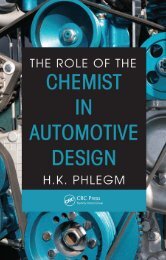Lightweight Electric/Hybrid Vehicle Design
Lightweight Electric/Hybrid Vehicle Design
Lightweight Electric/Hybrid Vehicle Design
Create successful ePaper yourself
Turn your PDF publications into a flip-book with our unique Google optimized e-Paper software.
Current EV design approaches 9<br />
with 110/0/110) the potential of the vehicle electrics is balanced to earth. When one end is<br />
earth (typical European situation) the potential of the vehicle electrics will move up and<br />
down at the supply frequency with respect to ground and there is the prospect of earth leakage<br />
current through any capacitance to earth of the vehicle electrical system. However, this is<br />
very small, usually because the tyres isolate the vehicle. However, when charging it would be<br />
desirable to ground the vehicle body to prevent any shocks from people touching the vehicle<br />
and standing on a grounded surface.<br />
1.2.7 ELECTRIC VEHICLE SPECIFICATIONS<br />
From the previous considerations one can now start the task of specifying EV capability/<br />
performance trade-offs. Polaron believe EVs will be partitioned as shown in Fig. 1.6. This does<br />
not pretend to be an exhaustive list but to show the range and scale of requirements to be provided<br />
for. The most interesting observation is that in the mass market, 30–150 kW, a solution is possible<br />
using just two sizes of drive, 45 and 75 kW. To complement the drives, motors are required of two<br />
speed ratings for each size, say 5000 rpm where compatibility with a prime mover is required, and<br />
12 000 rpm for the direct drive series hybrid/pure electric case.<br />
1.2.8 HYBRID VEHICLE EXAMPLES<br />
It is now proposed to have a look at two cases (a) 45 kW parallel hybrid vehicle; (b) 90 kW<br />
series hybrid vehicle, as in (Fig. 1.7). The 45 kW parallel hybrid vehicle consists of, typically,<br />
a small engine driving through a motor directly into the differential gear and hence to the road<br />
wheels. Minimization of weight is the key issue on such a design along with low rolling resistance<br />
and low drag. At 60 mph a good design can expect to draw 8 kW to keep going on a flat level<br />
road. The vehicle would be fitted with an engine rated to supply about one-third of the peak<br />
requirement, that is 15 kW plus an allowance for air conditioning if relevant. The motor has to<br />
deliver up to 45 kW using energy stored in batteries. This can be done either by a constant<br />
torque motor operating via a gearbox or a constant power motor operating with only two gears<br />
Power GVW Engine Motor Motor Turbo Application<br />
Rating type rating alternator<br />
Below Less than None Brush DC Up to None Straight battery<br />
40 kW 2 tons 40 KW electric van or car<br />
40 kW 2 ton IC Brushless DC 1 x 45 kW None Parallel hybrid<br />
−150 kW 5000 rpm family car<br />
2 ton GT Brushless DC 1 x 75 kW 1 x 100 kW Parallel hybrid<br />
12 000 rpm 60 000 rpm performance saloon<br />
3 ton IC Brushless DC 1 x 75 kW None Parallel hybrid<br />
5000 rpm 1 ton truck<br />
5 ton GT Brushless DC 2 x 45 kW 1 x 100 kW Series hybrid<br />
12 000 rpm 60 000 rpm 2 ton truck<br />
7 ton GT Brushless DC 2 x 75 kW 1 x 150 KW Series hybrid<br />
12 000 rpm 50 000 rpm single deck bus<br />
150 kW 10 ton GT Switched 1 x rating 1 x rating Heavy traction<br />
to reluctance 5000 rpm 50 000 rpm and road haulage<br />
motor at 150 kW<br />
1 MW 25 000 rpm Series hybrid<br />
40 tons at 1 MW configuration<br />
Fig. 1.6 Short-term battery electric and hybrid vehicles.







